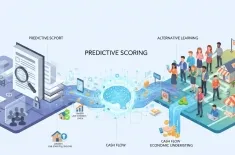Explore the Global Rise of Open Banking and Open Finance. How PSD2 drives financial data sharing via API connectivity,
The global financial sector is undergoing its most profound structural shift since the adoption of digital banking: the rise of Open Banking and its evolution into the broader paradigm of Open Finance. This transformation is fundamentally challenging the traditional, vertically integrated model where banks solely controlled their customers financial data. Instead, a new, decentralized ecosystem is emerging, driven by regulation and technological standards that prioritize customer empowerment and competition.
At its core, Open Banking—and subsequently Open Finance—is based on the principle of customer control over their own financial data sharing. When explicitly consented to by the customer, their financial data (transaction history, account details, etc.) can be securely shared with authorized third-party access providers, such as FinTech companies, through standardized technical interfaces. This regulatory-mandated data portability is the engine of innovation, compelling banks to open their digital doors and participate in an ecosystem previously dominated by their own proprietary products.
Open Banking: The Regulatory Catalyst and the PSD2 Mandate
The foundation of the global Open Banking movement was laid in Europe, primarily through the Revised Payment Services Directive (PSD2). Implemented across the European Union (EU) and the European Economic Area (EEA), PSD2 was more than just a payment rulebook; it was a legislative tool designed to break down long-standing barriers and stimulate a more competitive and innovative payments landscape.
Regulatory Frameworks and Data Sharing
The central mechanism of this revolution lies in the regulatory frameworks forcing banks to securely share customer data with third parties (with consent) to foster competition and innovation.
PSD2 mandates that Account Servicing Payment Service Providers (ASPSPs)—which are primarily banks—must allow two specific types of regulated third-party access providers (TPPs) to interface with customer accounts:
-
Account Information Service Providers (AISPs): TPPs that read and aggregate account information from one or more banks, enabling consumers to view all their accounts in a single dashboard, manage budgets, and receive personalized financial advice.
-
Payment Initiation Service Providers (PISPs): TPPs that initiate payments directly from the customers bank account to a merchant, bypassing traditional card networks.
This mandate is enforced using API connectivity (Application Programming Interfaces). APIs act as the secure, standardized pipes that connect the banks core systems to the TPPs, ensuring the data transfer is encrypted, authenticated, and fully auditable. The use of robust API connectivity is crucial because it ensures that only the minimum necessary financial data sharing occurs, protecting consumer privacy and security.
Key Drivers of PSD2
| Driver | Description | Outcome |
| Competition | Breaking the banks monopoly on customer data to allow new FinTech players to offer services. | Lower costs, increased choice, better service quality. |
| Innovation | Enabling third-party access to data allows FinTechs to build bespoke, customer-centric products. | Real-time lending, automated budgeting, and aggregated financial views. |
| Security | Mandating secure API connectivity to replace less secure methods like screen scraping. | Higher data protection standards and reduced fraud risk. |
The UK, a pioneer in this field, built upon PSD2 with its own Open Banking Implementation Entity (OBIE) to accelerate the standards and adoption, turning the UK into a global blueprint for a regulatory-led approach.
The Global Expansion: From Open Banking to Open Finance
While Europe focused initially on payments and current accounts, the success of Open Banking has fueled a global trend that is quickly expanding into Open Finance.
Open Finance is the logical evolution of Open Banking. It extends the principle of consented financial data sharing beyond current accounts and payments to a much wider range of financial products and services, including:
-
Investments and Wealth Management: Sharing portfolio holdings, transaction history, and asset performance.
-
Pensions: Aggregating retirement savings information.
-
Insurance: Sharing policy details and claims history to allow for personalized pricing and product comparison.
-
Mortgages and Loans: Providing verified income and expense data for faster, automated credit scoring.
The global landscape is characterized by diverse implementation models:
-
Regulatory-Driven (Mandatory): Europe (PSD2), Australia (CDR), and Brazil, where regulation forces banks to participate.
-
Market-Driven (Voluntary): The United States, where major banks collaborate with FinTechs using API connectivity but lack a single federal mandate, leading to fragmented standards.
-
Hybrid Models: Countries like Singapore and Japan, where central authorities issue guidelines and promote API connectivity without a strict, mandatory requirement.
Cross-Border Integration and Harmonization
A key challenge and opportunity for the future is cross-border integration. As data standards become more uniform, the potential for pan-regional and global Open Finance products grows exponentially. For instance, a small business operating across the EU could use a single app to manage cash flow across multiple bank accounts in different member states, initiating payments and reconciling accounts automatically. The push for further harmonization, often referred to as PSD3 in Europe, aims to solidify the rules for TPPs and banks, facilitating seamless data exchange across national borders.
The Impact: Competition, Innovation, and Use Cases
The introduction of mandated financial data sharing through API connectivity has triggered a massive wave of innovation, shifting the competitive dynamic from product-centricity to data-centricity.
Fostering Competition
By granting third-party access, Open Banking effectively modularizes the financial services value chain. Banks are forced to compete on the quality of their underlying accounts, while TPPs compete on the quality of the applications built on top of the shared data. This has led to:
-
New Entrants: Rapid growth of FinTechs and challenger banks offering hyper-personalized, often cheaper, services (e.g., instant payments, automated savings).
-
Reduced Friction: Seamless switching between providers, as customers can easily transfer their history and identity data, thereby increasing pressure on incumbents to improve service.
Driving Innovation and Embedded Finance
The most transformative aspect is the ability to create entirely new products. The aggregation of data allows for a comprehensive, 360-degree view of a customers finances, enabling:
-
Real-time Lending: Lenders can instantly access verified bank statement data to assess creditworthiness, making lending decisions in minutes rather than days—a significant benefit for small and medium-sized enterprises (SMEs).
-
Personal Financial Management (PFM): Apps can categorize spending across multiple accounts and provide automated, personalized budgeting advice and savings recommendations.
-
Embedded Finance: Financial services are integrated directly into non-financial platforms. For example, accounting software can use API connectivity to initiate payments directly from a business bank account or automatically reconcile bank transactions, creating seamless end-to-end business workflows. Open Finance accelerates this trend by embedding investment and insurance services alongside payments.
Financial Inclusion and Security
Open Banking enhances financial inclusion by providing alternative credit scoring models. For individuals or SMEs with thin credit files, sharing consented transaction data provides lenders with a verifiable track record, allowing them access to credit they would otherwise be denied.
Furthermore, the mandated use of secure API connectivity under regulations like PSD2 is inherently more secure than the screen-scraping methods previously used by many FinTechs, which required customers to share their actual banking credentials. The official framework ensures data is shared securely, only for the consented purpose, and only the TPPs themselves are authorized through robust cryptographic certificates.
Conclusion: The Future of Open Finance and Open Data
The journey from Open Banking to Open Finance represents an irreversible shift in how financial power is distributed. What started with the regulatory push of PSD2 in Europe has become a global phenomenon, with markets like Brazil and Australia demonstrating rapid and successful national implementations under their own respective frameworks.
The future points toward Open Data, where the principles of customer-controlled third-party access and secure API connectivity are extended across all sectors—telecom, utilities, healthcare, and government—creating a unified data economy. However, the success of this global experiment hinges on overcoming two persistent challenges: achieving greater cross-border integration through global regulatory harmonization, and maintaining absolute consumer trust through transparent consent mechanisms and robust data security.
Ultimately, the Global Rise of Open Banking and Open Finance signifies the commoditization of financial data access, driving an era of unprecedented competition and customer-centric innovation.




























